December 15, 2022
Welcome to Courmelles Aerodrome, on the southwest outskirts of Soissons, for a tour of the French “Aisne Sector” of the Western Front today in MSFS, in the Dorand AR.1.

The Dorand AR.1 is a two-seat observation biplane (the AR stands for Avion de Reconnaissance) developed in 1916, in response to the newer, deadlier fighter planes being flown by the Germans.

As you can see, the skin is fabric stretched over a wooden frame. The pilot sits up front, near the front edge of the wings, while the observer sits behind, and has a Lewis machine gun.

Depending on the model, the AR.1 was powered by a Renault engine delivering 160-200 horsepower (engine shortages were a major factor at that point in the war, so they made due).

The Dorand AR.1 was not named after its designer, Captain Georges Lepère, but in honor of his boss, the head of the state-owned French Army Aircraft Establishment (or STAé), Lt. Col. Dorand. It’s good to be king.

The AR.1 arrived into service in the spring of 1917, just in time to participate in the Neville Offensive, a big attack against the Germans along the Western Front planned by the famously aggressive General Robert Nivelle.

The solid blue arrows on this map show where the Neville Offensive took place (complemented by a British offensive to the northwest centered on Arras).

The western hinge of the French effort was the city of Soissons (below), along the Aisne River, which gives its name to the front and to the battle.

There were about a dozen squadrons of AR.1s. Their job was to fly over the German lines and take note of deployments and fortifications for the artillery bombardment and infantry attacks to follow.

The front lines, in this case, was a long straight road along the top of a ridge that started just north of Soissons and ran east, called the Chemin des Dames.

The Chemin des Dames was named after two daughters of King Louis XV, who used to travel along it to their nearby estate in the 18th Century. But the route has long has strategic significance, going back to the Celtic tribes.
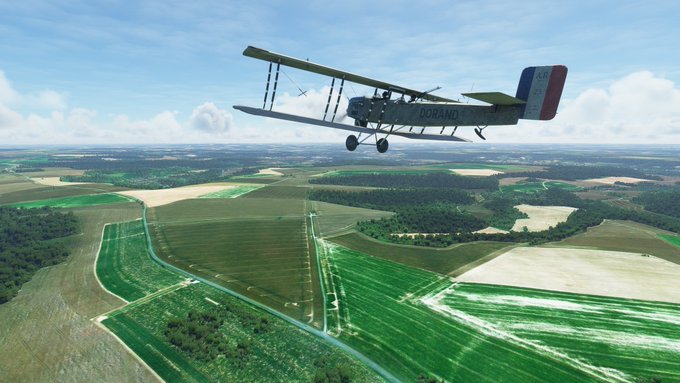
After the French blocked them from reaching Paris at the Battle of the Marne, in 1914, the Germans retreated to this ridge, just north of an east-west stretch of the marshy River Aisne, and dug in.

Vicious fighting raged along the Chemin des Dames for nearly the duration of the war. There were no less than three large-scale Battles of the Aisne. Below me, at the road intersection, is a chapel and cemetery in the village of Cerny-en-Laonnois devoted to those killed.

The building below to my left, a bit further on, is the entrance to an underground stronghold called the Cave of the Dragon, which changed hands between the French and the Germans multiple times.

The Chemin des Dames is anchored on its east by the town of Craonne, where Napoleon defeated a combined Russian and Prussian army led by Prussian Field Marshal von Blücher, in 1814, one hundred years before World War I.

You can see the gentle slope of the Chemin des Dames ridge behind me, as I continue to the southeast. High ground like this might not look very impressive, but it could make all the strategic difference on the Western Front.

Here are Berry-au-Bac, on the River Aisne itself, the French launched their first tank attack of the war, as part of the Nivelle Offensive. They got bogged down in the marshy ground, and 73 of the 128 Schneider tanks were lost.

Like the tank attack, the Nivelle Offensive as a whole proved a costly disaster. The French failed to break through the German lines, and lost an estimated 187,000 men (with the British losing another 160,000 in related attacks).

Nivelle was replaced with General Philippe Pétain, who adopted a more defensive stance. Pétain had no choice; several mutinies broke out among French troops on the front, in response to their horrific losses during the recent attacks.

The mutinies were put down, but the French were unable to launch any other offensives for the rest of 1917, putting a great burden on the British to the northwest. We’re approaching the city of Reims here, on the eastern edge of the Aisne Sector.

Reims was briefly occupied by the Germans in 1914, and was later shelled by them, largely (and perhaps intentionally) destroying the historic cathedral where French kings were traditionally crowned.
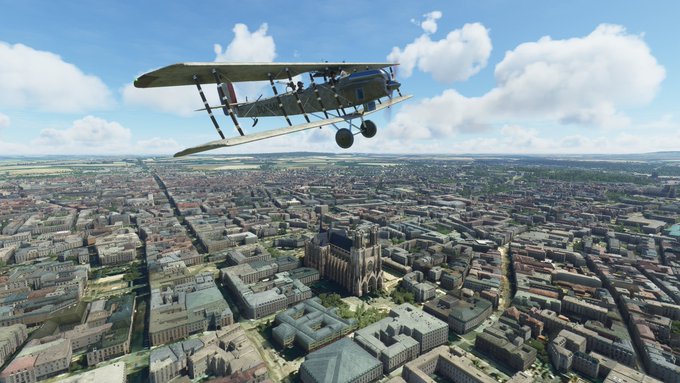
The outer shell still stood, however, and Reims Cathedral was rebuilt after the war.

Buzzing the Cathedral at Reims is a good opportunity to mention that the instruments in my cockpit today are not authentic/original.

The original dials and controls would have been far simpler. You can imagine that this would be a modern restoration, in order to be flown more easily (and safely).

Like the Nivelle Offensive, the Dorand AR.1 did not have a particularly successful career. It performed its duties as required, but was quickly outclassed by further advances in enemy aircraft.

By the end of 1917, the AR.1 was replaced in French service by better, more modern aircraft, and relegated to the role of trainers. Or given to the newly arriving Americans, as we shall see in a moment.

Entering the pattern for a landing at Prunay Airport, on the southeast outskirts of Reims. Very few original World War I air bases still exist, because they were basically just cleared fields in the countryside.

Touched down gently and didn’t ground loops or nose over. Yay.

The defeat of the Nivelle Offensive came as a hard blow to France …

But this was partly offset by the entry of the Americans into the war, in April 1917. By the end of the year, the first US troops were arriving in France, and they didn’t bring any airplanes with them, so they got French castoffs … including the Dorand AR.1.
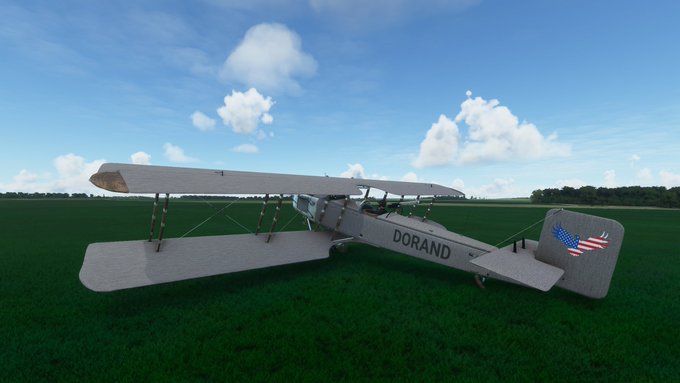
Despite big promises, the Americans never did deliver any airplanes to the Allied cause, and relied entirely on French ones. The main reason was problems with the US-designed “Liberty Motor”. Over 20,000 were eventually produced, but too late to arrive in France.

I’m taking off here from a grass airstrip at Montdidier, about 50 miles north of Paris. This would have been just behind German lines in May 1918, but it’s as close as I can get to the village of Cantigny.

After the collapse of Russia into revolution in 1917, the Germans were able to shift huge numbers of soldiers from the former Eastern to the Western Front. In the spring of 1918, they launched a massive offensive to win the war.

The German offensive was finally stopped, here along the tributaries of the River Somme.

And it was here, at the small village of Cantigny, as part of the Allied counter-attack, where the newly arrived American troops would participate in their first offensive of the war.

Lt. Col. George C. Marshall (later Chief of Staff of the US Army in World War II, as well as Secretary of Defense and State) planned the attack on Cantigny as operations officer for the First Division, the Big Red One.

The only observation aircraft he would have had to scout the battlefield in advance were Dorand AR.1s, provided to the American Expeditionary Forces by the French.

Across these fields, on the morning of May 28, 1918, US troops left their trenches for the first time in World War I and advanced to capture the village of Cantigny from the Germans.

They suffered 1,603 casualties, including 318 killed – nearly 1/4 of their number. But the relatively small attack was a success, and signified that a new factor was at play on the Western Front, one that would grow larger as the months progressed and more Americans arrived.

As for the Dorand AR.1, the Americans in France also soon replaced it with newer, better aircraft. The plane saw service with French squadrons in Italy, but by late 1918 was handed down to the Serbians and Greeks.
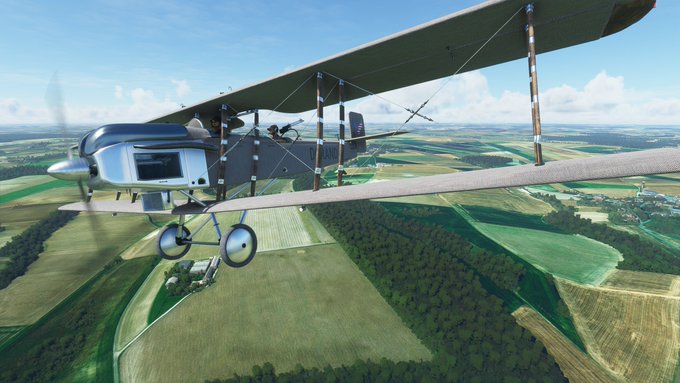
Aircraft development during World War I was so fast, few aircraft models could last more than a year before they were rendered obsolete. The same was true for the Dorand AR.1.

On final approach to land back on the grass runway at Montdidier. For planes like these, pilots relied less on recommended speeds and more on the touch of the controls. If you have to hold too much back pressure on the stick, you know you’re in danger of stalling.
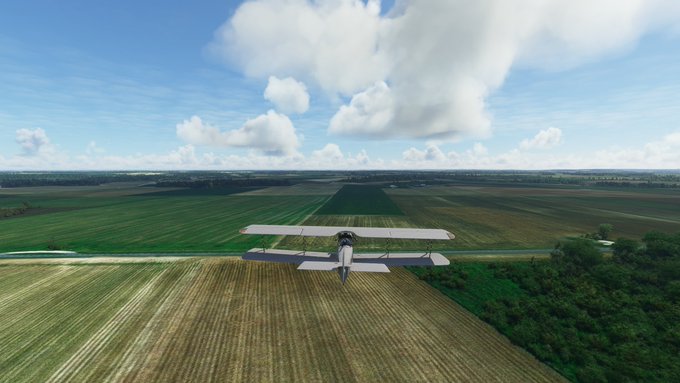
No one became famous flying a Dorand AR.1. These weren’t fighter aces racking up kills. They flew where they were assigned to gather information, and tried to make it back without getting shot down. I hope you found their perspective interesting.

Leave a Reply